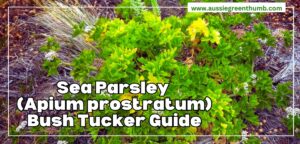Sorrel has an unmistakably bitter flavour, that when mixed with fresh tomatoes and a sweet dressing makes for an incredibly delicious summer salad, and on top of that its probably the easiest leafy green you can grow at home. Here’s how.
More...
Family: | Polygonaceae |
|---|---|
Genus: | Rumex |
Species: | R. acetosa, R. sanguineus, various others |
Common names: | Sorrel, Red-veined sorrel, Garden sorrel, Spinach dock, Narrow-leaved dock |
Origin: | Worldwide, predominantly Europe |
Location: | Outdoor or indoor |
Type: | Herbaceous perennial, edible |
Growth: | Up to 60 cm x 60 cm |
Sun requirements: | Full sun or light shade |
Foliage colour: | Green or red |
Flower colour: | Green |
Flowering: | Spring to autumn |
Edible parts: | Leaves |
Maintenance level: | Low |
Poisonous for pets: | Toxic to cats and dogs |
What is Sorrel?

Sorrel is a leafy herbaceous perennial in the dock family (Polygonaceae), which gives it several of its common names (Spinach dock, Narrow-leaved dock, red dock).
Sorrel has a tap root, like other members of the dock family, so will come back year after year, spreading into a clump and providing even more leaves in its second year. It will grow in most soil types, and most light conditions, but has a few distinct preferences that not only boost its growth but improve its flavour.
There are several species and cultivars of sorrel that have been naturalised in Australia, and it can actually become quite invasive if left to seed. However, with cultivation for the leaf and leaf only, sorrel is easy to manage, quick to crop, and a beautiful addition to any summer or winter salad.
Identifying Sorrel
Sorrel is from a family of plants with a high oxalic acid content, which isn’t toxic to humans or pets in small amounts but can be if you pick the wrong plant.
Common sorrel is green, with a slight dimpling to the leaf. The central ridge is pale green or green-yellow, and each leaf typically grows to about 10-15 cm long and 5-7 cm across (though younger leaves have better flavour). When sorrel flowers it has a single, central flower spike for each plant, with leaves growing alternately up the stem, topped with small green or red flowers in dense clusters.
Red sorrel shares the same identifiers but has distinct blood-red veining across the central rib of the leaf, and the lateral veins too. It is easier to identify and has a much more versatile flavour and texture than green sorrel.
What is Sorrel’s Natural Habitat?
Sorrel is a widespread plant, native to central Europe, but grows well in nearly every climate and country in the world. The only conditions that sorrel won’t cope with are deep, prolonged frosts. A long winter frost in Australia or most of Europe won’t harm sorrel, and it will come back each year, but it is famously hard to grow in Russia for that reason.
Sorrel will compete with grasses, and other plants to get a foothold, and once rooted it will adapt its foliage to either grow flatter in clusters or taller to compete with grass or ground-covering plants.
Common Uses of Sorrel
Sorrel is almost exclusively used as a salad leaf, but it works beautifully as a zesty alternative to spinach and can be wilted or stir-fried in just the same way.
The Best Types Sorrel to Grow in Australia
There are four major groups of edible, cultivated sorrel, but many more species, subspecies and specific cultivars worth exploring if you fancy a deep dive into this diverse and leafy world.
The four most common edible sorrels are common sorrel, red-veined sorrel, sheep’s sorrel and wood sorrel. All are delicious salad crops, but there are some cultivation tips that are unique to each, and flavour profiles that are worth considering before choosing which to plant.
1. Common Sorrel (Rumex acetosa)
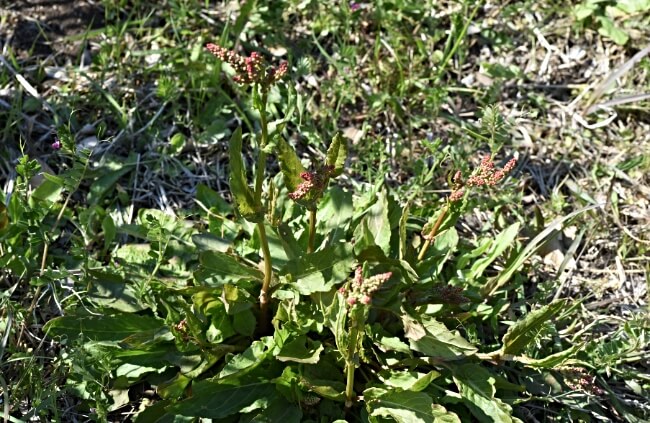
Common sorrel, also called garden sorrel and spinach dock, is the most typical sorrel found growing in gardens and as a weed in public parks and roadsides. Its leaves are subtly bitter, and have a sturdy texture when eaten raw, offering great fibre, iron and antioxidants to any salad.
It is also ideal for freezing and makes a big improvement on spinach when wilted, steamed or fried.


Get Your Free Guide:
Master Growing Australian Natives eBook
A Must Have Complete Guide for Every Australian Garden
Get Your Free Guide:
Master Growing Australian Natives eBook
A Must Have Complete Guide for Every Australian Garden
Common sorrel grows to about 60 cm across, with a 60 cm tall flower spike, and a tap root that is roughly the same size, so needs deep pots or well-drained garden beds to accommodate healthy growth. Annual or biannual division is strongly advised to keep the spread of these beautiful edible plants in check.
2. Red Veined Sorrel (Rumex sanguineus)

Red-veined sorrel has a finer leaf than common sorrel, and can be harvested as soon as it germinates for microgreens, or left to develop into long leaves for more dramatic colour in salads.
Red sorrel is the most common sorrel for veggie gardeners because it has a lighter flavour, and an earthier undertone, but it also offers much more interest for ornamental gardeners.
Despite its flavour differences and the slightly different leaf texture, red-veined sorrel grows nearly identically to common sorrel, in shape and size, but has distinct watering and feeding needs if you want to get the best colour and flavour from it.
3. Wood Sorrel (Oxalis acetosella)
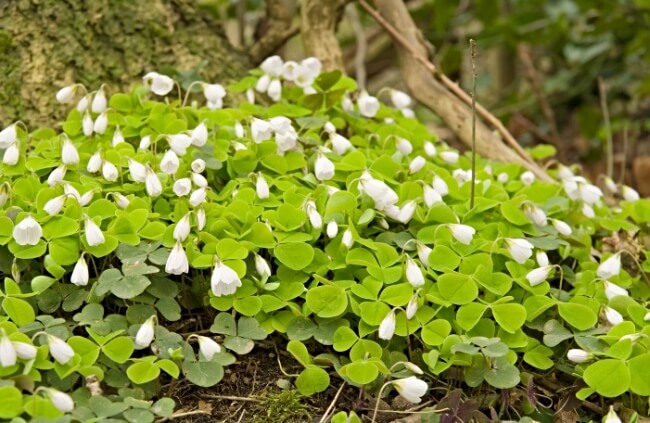
Wood sorrel, or common wood sorrel, is an entirely different plant, in an entirely different genus, but its foliage is used in exactly the same way as common or red sorrel. There are obvious visual differences in how common wood sorrel grows, with clover-like leaves and a lower habit.
Common wood sorrel typically produces 30cm domes and prefers moist soil. There are multiple cultivars and subspecies of Oxalis, including yellow sorrel and pink sorrel.
4. Sheep’s Sorrel (Rumex acetosella)
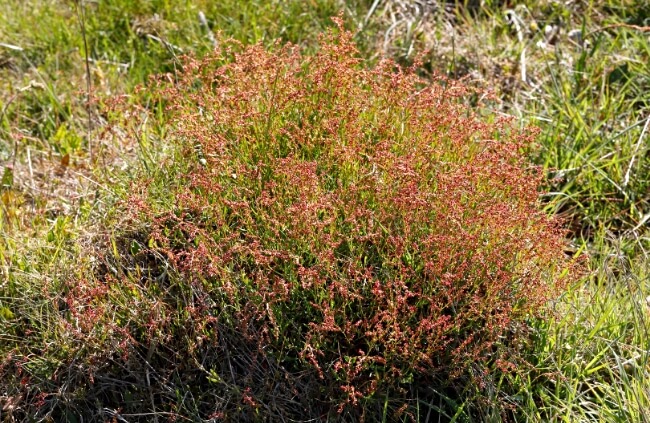
Sheep’s sorrel, also called red sorrel, is a European wildflower, with fine leaves and beautiful red flowers. It is nearly always talked about as a weed, rather than a crop, but it has a beautiful texture and a soft sour kick to its foliage.
It will grow well in mixed borders and beds without needing to be too tidy about your veggie beds. Ideal for permaculturists.
How to Grow Sorrel
Honestly, if you’ve grown sorrel before, it's probably easier to just leave it alone than to put effort in. Sorrel will just grow, if you sow the seeds, or transplant young plants into any reasonably drained conditions, it will thrive.
And because sorrel is so simple to grow from seed, I would strongly suggest starting all of your sorrel crops that way, but if you’re not much of a green thumb, you can usually find sorrel plug plants available in good garden centres in early spring and summer.
How to Propagate Sorrel
Because sorrel can develop into a clump-forming perennial if left to its own devices, I wanted to share two ways of propagating these tasty plants. The first is obviously from seed, but the second is perhaps a little unorthodox; division.
Here are step-by-step guides on how to do both.
Propagating Sorrel from Seeds
Sowing sorrel couldn’t be simpler. It likes reasonably warm conditions, even moisture during germination, and plenty of indirect light while roots get established.
The two methods of sowing sorrel are to sow directly or to sow in plugs. Sorrel is a tough plant, so don't mind being transplanted, and in colder parts of Australia, this can give you a head start in late winter.
Method one: Direct sowing
- Prepare a seedbed by removing any perennial weeds.
- Spread a 5 cm layer of compost to the soil surface, and rake it in.
- Draw out drills, 1 cm deep and 30 cm apart, then water the empty drills.
- Sow sorrel seeds about 15 cm apart, then cover over with soil.
- Water again with a fine spray so you don’t dislodge the seeds.
- Germination typically takes 14-21 days. Keep the soil moist during this time.
- After germination, thin any stray seedlings to 15 cm apart.
- Feed with a light dilution of tomato food or balanced organic fertiliser.
Method two: Sowing in plugs
- Fill plug trays with seed compost or sieved multi-purpose compost, leaving 1 cm of space between the soil surface and the plug’s rim.
- Sow one seed into each plug, then cover lightly with 0.5 cm of compost or vermiculite.
- Water from the top or by placing the tray into water to soak up.
- Germination takes 14-21 days, so keep the soil moist.
- After germination, move the tray somewhere bright, and allow the plants to develop several leaves.
- When the plugs have roots visible at the base, they’re ready to plant in the garden, or windowsill containers.
Propagating Sorrel from Division
Sorrel and red-veined sorrel will both form clumps. Their roots are well adapted to this, and it makes it incredibly easy to rejuvenate plants.
Red sorrel is at its best in its first year, and is quite a hungry plant, taking up whatever nutrients it can, while being able to grow in very poor conditions too. So any sorrel that grows on to this second or third year will need to be divided. You can do this by removing half the clump and filling compost in to feed the original plant, or by splitting plants in pots, and repotting each section into new compost.
Both are simple and effective ways of keeping your sorrel crops going year after year.
The Best Position for Growing Sorrel
The most important thing you’ll read in this article, and something I will repeat again, is that sorrel is a hungry plant that will take everything it’s given, but it doesn’t actually need it.
That doesn’t mean you can neglect it, and your crops will suffer in flavour and vigour in poor conditions, but it does mean that you don’t need to spend loads on feed and fertilisers. Follow the steps below to get the soil conditions just right, and find the best light for growing red-veined sorrel and common sorrel.
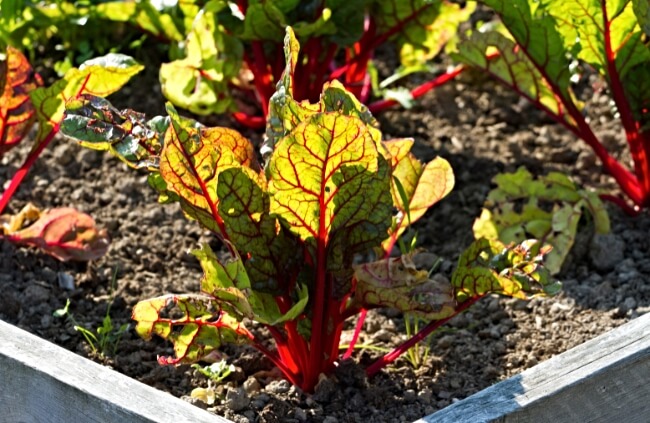
Soil & Drainage
Sorrel prefers well-drained soil, and the richer it is, the better. Often we think of fertile soil being stuffy, heavy clays, but you can use rotted manure and even your own garden compost to add drainage, as well as nutrition to soil with bad drainage.
Simply mulching your beds will help to aerate and drain them as worms do everything else for you. And once your sorrel is planted, it offers a useful indication of soil health. Red veined sorrel will have red tips if it is stressed, and green foliage with neat veining if it’s got enough nutrients for full flavour.
In pots and containers, simply fill them with multi-purpose peat-free compost for reliable sorrel growth. In the ground, mulch your beds a few weeks before planting to get organic nutrition into the ground, ready for crops.
Light & Temperature
Sorrel loves full sun if you’ve got it, but it will grow as a woodland edge plant in the shade of tall trees or hedges with ease. In very warm parts of Australia, some shade is advisable for sorrel growers. In cooler parts, aim for 8 hours of direct sun per day.
When it comes to winter, Sorrel doesn’t like sitting in boggy conditions, but will generally cope with frost and average winter rainfall on any plot.
Planting Sorrel
If you’ve got sorrel plug plants from a garden centre or nursery, the best time to plant them is now, whenever now might be. They can be planted at any time of year, but add a good amount of organic compost to the planting hole and firm them in well.
It’s also worth noting that sorrel doesn’t just need to be restricted to the veggie plot. It’s equally well suited to ornamental gardens, with different varieties having different flowering habits, while their foliage offers limitless interest, and both are great for wildlife.
Companion Planting with Sorrel
Sorrel is a particularly good companion plant for mint as it can restrict and compete in pots with the fragrant thug. It is also useful to plant alongside strawberries to make more of the available space and would make an excellent sacrificial border plant to distract slugs from more prized flowering plants and crops.
How to Care for Sorrel
Sorrel doesn’t take much care especially once it's established, but regular annual division of mature plants helps to keep it growing strongly, and offers opportunities to feed with garden compost.
Watering isn’t too important either, but as I’ll explain below, can be the difference between a good sorrel and a leaf that may as well be spinach.

Mulching Needs
Mulching perhaps isn’t the right word, as neither red sorrel nor common sorrel require mulch to protect from frost or excess moisture. They do however benefit from fresh compost, whether it's added during division, or spread in a 2-3 cm layer each spring to lightly feed the plant and support its growth through summer.
Feeding Sorrel
If you prefer not to mulch, or grow sorrel in pots, then feeding is a great alternative. Any blanched organic fertiliser works wonders for sorrel. Liquid seaweed, applied monthly as a strongly diluted feed (two caps per 7L watering can), is ideal and supports strong root growth, and nutrient uptake, which improves the flavour but will also have visible effects on the leaf health and colour too.
Watering Sorrel
Sorrel likes good drainage and can cope with drought, even in the hottest Australian summer. However, if you choose to neglect your sorrel, it won’t thank you.
Dry soil leads to poor nutrient uptake, and that leads to stressed plants. Not only will that trigger flowering too early in the season, but it can massively reduce the flavour of your sorrel.
Red-veined sorrel is the easiest variety to manage watering, as stressed plants develop red tips to their leaves, in addition to the red veining they should have.
Harvesting and Storing Sorrel
Sorrel is best eaten as soon as possible after picking, as it has a lovely, light, crunch, but it can be kept in the fridge for about a week before its texture really deteriorates. Keep in a paper bag or air-tight bag with a paper towel in the crisper drawer of the fridge for best results.
Alternatively, you can freeze sorrel for use in sauces and casseroles later in the year. The process is pretty simple and identical to spinach. Steam the leaves, then squeeze out excess moisture, before freezing in an ice cube tray.
The frozen cubes can then be stored in a bag and added to sauces to quickly defrost and add instant flavour, and tons of nutrients.
Common Problems When Growing Sorrel
Sorrel rarely has any major growing problems, but slugs and snails will be a headache to any gardener growing leafy greens. Diseases are very limited, and almost exclusively caused by overwatering and aphid damage.
Sorrel Pests
There are three common pests that really do affect sorrel: aphids, slugs and snails. Sadly, they are the pests that we are least likely to ever get rid of, and they do, admittedly, serve their function in the garden, either as food for birds and other insects or in helping to churn fallen leaves into the soil.
However, with a crop entirely used for its leaf, keeping slugs and snails at bay is critical. The most reliable way we’ve found is by using used coffee grounds, but beer traps can work just as well. Adding a pond to your garden will encourage other wildlife that will eat the slugs and reduce their numbers too.
As for aphids, they generally only affect the flowering stems of sorrel, but you do occasionally find them on the underside of healthy leaves. Blast them off once in a while with a hose, and cut off flowering stems if they're infested.
Tip: Most coffee shops will give you bin bags full of used coffee grounds if you ask nicely.
Sorrel Diseases
Overwatering, and watering the leaves of sorrel on hot days almost invariably causes fungal problems. This can be avoided by watering the soil, either with drip irrigation or just watering gently with a watering can to avoid splashing back onto sorrel leaves.
Powdery and downy mildew are the most common fungal problems with sorrel. To treat, simply remove the affected foliage and allow the rest of the plant to dry off for a few days. Dry weather and reduced watering usually put a stop to mildew.
Pro Tips for Growing Sorrel at Home
My best tip for growing sorrel isn’t so much about sorrel as a crop but about sorrel as an ornamental plant. Red sorrel in particular takes on a whole new identity when planted into mixed borders. The stress of competition for nutrients, and taller herbaceous planting means that its leaves grow vertically, and you get a taller plant with a stunning leaf pattern and a wonderfully structural flower spike.
The flower spike is particularly attractive to insects and helps to attract ladybugs to the garden, which predate aphids and other common pests.
Frequently Asked Questions About Sorrel
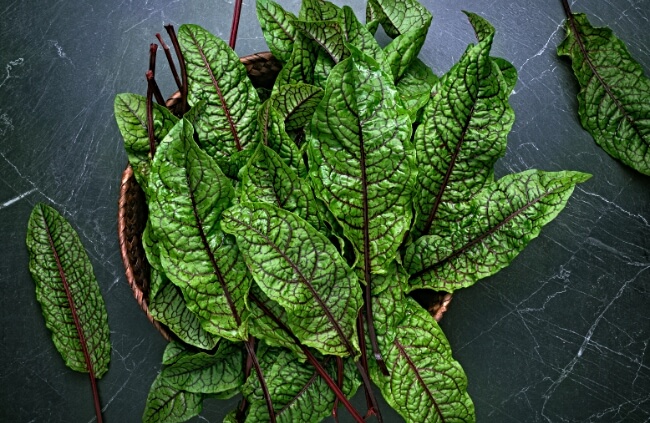
Where does sorrel grow best?
Sorrel grows best in rich, well-drained soil in full sun, but will tolerate part shade, and poor soils reasonably well. In hotter climates, sorrel is better suited to light shade.
How invasive is sorrel?
Sorrel is a very invasive plant if left to go to seed. In cultivated spaces, and well-cared-for gardens it rarely gets a hold, as seedlings are easy to pull up, and it is simple to deadhead when flowers fade.
Is sorrel cut and come again?
Sorrel is the ultimate cut-and-come-again salad leaf for any garden, providing repeat leaves all spring, summer and autumn, and a reliable return for several years after that.
Is sorrel good for the garden?
Sorrel is a wonderful plant for your garden, not just visually, but also as an indicator of soil health. As a reliable perennial, that gets stronger year after year, sorrel is perfect for ornamental and edible gardens alike.
How much space does sorrel take to grow?
Sorrel plants should be planted about 30cm apart, as they develop into quite large plants in their second year. For young leaves, and to grow sorrel as a single-year crop, it can be planted much closer together, but you will need to remove most plants if some are to go through winter.
Is sorrel poisonous?
Sorrel is not poisonous but it does contain oxalic acid, which is toxic in large amounts. Pets are more susceptible to the toxic effects, but it takes a large amount for it to be dangerous.
Can you eat garden sorrel raw?
Garden sorrel and red-veined sorrel are best eaten raw. Their flavour is beautifully sharp, and the fresher you eat them, the better their texture is.
How often should I water my sorrel?
How often you water your sorrel will depend on its soil conditions and light levels, but watering once a week is a good rule of thumb, or whenever the soil appears dry.
Does sorrel have deep roots?
Sorrel has very deep roots for a plant of its size, often reaching as far as 1 m into the soil. That makes it very hard to get rid of, as it can come back from snapped tap roots.
Wrapping Up Our Guide to Growing Sorrel
When you think of growing your own salads, sorrel probably isn’t first on your list, but alternative salad leaves like sorrel, and nasturtiums are packed with more diverse nutrients than common lettuces and add beauty to your veggie patch as well as flavour.
If you’ve got limited space, sorrel is a great choice too, because it is happy in confined conditions, responds well to feeding and watering, and can cope with a little competition. Growing sorrel in Australia couldn’t be easier, so get yourself to a garden centre and buy yourself a pack of seeds.
Published on August 21, 2025 by Maisie Blevins
Last Updated on October 14, 2025


